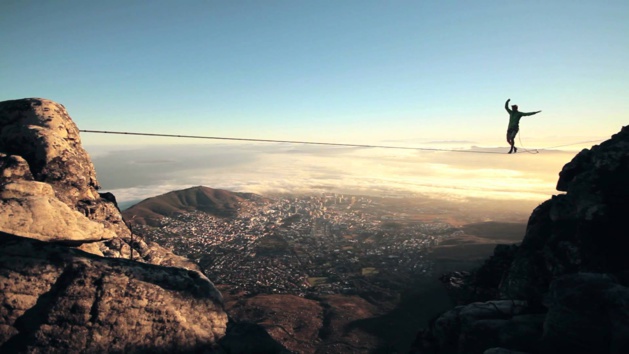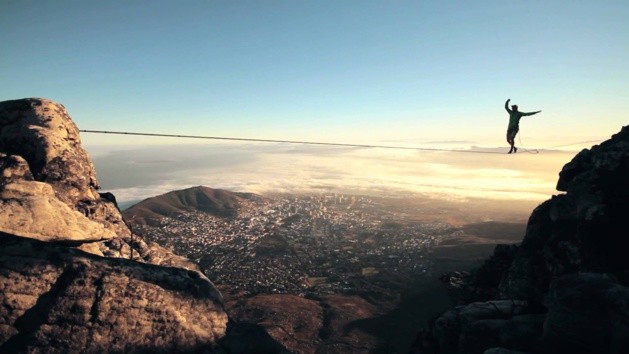
Credits RR
Similar to tightrope walking, Slacklining is different because of the fact that an elastic webbing is needed instead of static steel wire in order to be able to cross with balance. Even though its origin is unclear, this activity may have been born in California when surfers were looking for a way to keep their balance when waves were low. In the 80s, Yosemite climbers started to use Slacklining while mixing it with climbing.
Slacklining was the privilege of some purist sportsmen, who wanted to improve their balance. But with the increasing desire to discover this trendy activity and to improve, the practice developed around associations and competitions were born. The width of the webbing can vary between 2.5 and 5 centimetres according to the model, and if the first steps on a slack line are always laborious, perseverance leads to fast progress. We move very quickly to bigger lengths or to more complex tricks.
A fun and trendy practice
The secret of the slack line lies in its ability to be set up almost everywhere, and very fast. All it needs is to find two static points solid enough to hold the tension and all you have to do is express yourself. We can never grow tired of this activity because we can change its location wherever we like. The advantage is that it is easily removable and due to the diversity of the environment and the material, the practice is varied: shortline, longline, trickline, highline, waterline.
There are always new sensations waiting to be explored. Accessible to all without training, Slacklining gathers in conviviality. In family or between friends, it is a way to spend a pleasant time and to relax. It is also an occasion to meet people and exchange conversations. The curious stop to watch, the more daring ask you if they can try. Benjamin, member of Ekilibre Valence rejoices; « more and more people are joining our association, Slacklining draws people because it is new, fun and accessible to all ». It turns out that, while indulging ourselves, Slacklining is also beneficial for the body and health. Except from developing balance, it strengthens the sheathe and the inferior parts of the body. This is why it has been recently used in physiotherapy for the work of proprioception and muscular strengthening.
A good meditation exercise
Once on the webbing, it is essential to withdraw within one’s self. The spirit must be entirely focused on the objective: cross the webbing. The oscillations of the spirit have an impact on the webbing. It is necessary to clear our thoughts and to be one with the webbing. If the attention is focused on other thoughts, the risk of falling rises. This state of mind can be thought of as meditation. Slacklining helps develop the ability to concentrate. All the specialists of the discipline, most notably in highline, are seeking this powerful sensation: be in symbiosis with the environment. Benjamin says: « highlining gives me inexplicable sensations. The sensation to fly, the desire to put myself to the test psychologically and physically, it is a very spiritual sport. There is also this pursuit of adrenaline, but in reality if all the security measures are respected; there is nothing to fear. »
Even though it is impressive, this activity is actually really secure and the only accident that was noted happened in Slovenia in 2011 because of the ignorance of the practice, which was still relatively young at the time. For Benjamin, « we are judicious in the preparation of the line and reckless when we climb on it, the brain needs to be disconnected, everything happens in the head. »
Léo Raguet, member of Ekilibre Lyon, adds « in highline we never forget the fear of heights; the goal is to walk with this fear, to accept it. It needs to be sufficiently present for us to fight in case of difficulty but it cannot overcome us and scare us to the point that we cannot walk. This fear is something that keeps us more alert and reactive than we would normally be. Accepting this fear is the strongest sensation in highline, it is what makes us cry, what gives us the most sensations… Walking with our eyes down to see the ground 300m lower. »
The Flying Frenchies, precursors and pioneers
Behind the almost barbaric name of the Flying Frenchies hides a collective of extreme sportsmen and artists who challenge the law of gravity and who, between fear and admiration, force respect. They appear in “ I believe I can fly” and “ The small red bus”, two movies realized by Sebastien Montaz, who contributed to the ascent of the practice of the slackline. These movies share, among others, the exploit of Tancrede Mellet and Julien Millot, two former engineers who decided to leave everything behind to live from their passion. They always push back the mental limits, combining highline and base jump or realising solo crosses without any security means.
The only limit to their imagination is the decor they are offered. They were recently talked about by setting webbing between two hot air balloons or two cable cars. The Flying Frenchies gather sportsmen, artists and musicians for a most astonishing mixture. Such as this clown impersonated by Anicet Leon, who adds to these movies a tint of laugh, self-mockery and marks a uninhibited approach to this frightening environment that is the void. But do not fool yourselves, these are professionals, their stunts are carefully studied because when Slacklining, the fall is only a few centimetres from balance… All needed to tame Icare’s dream.




























